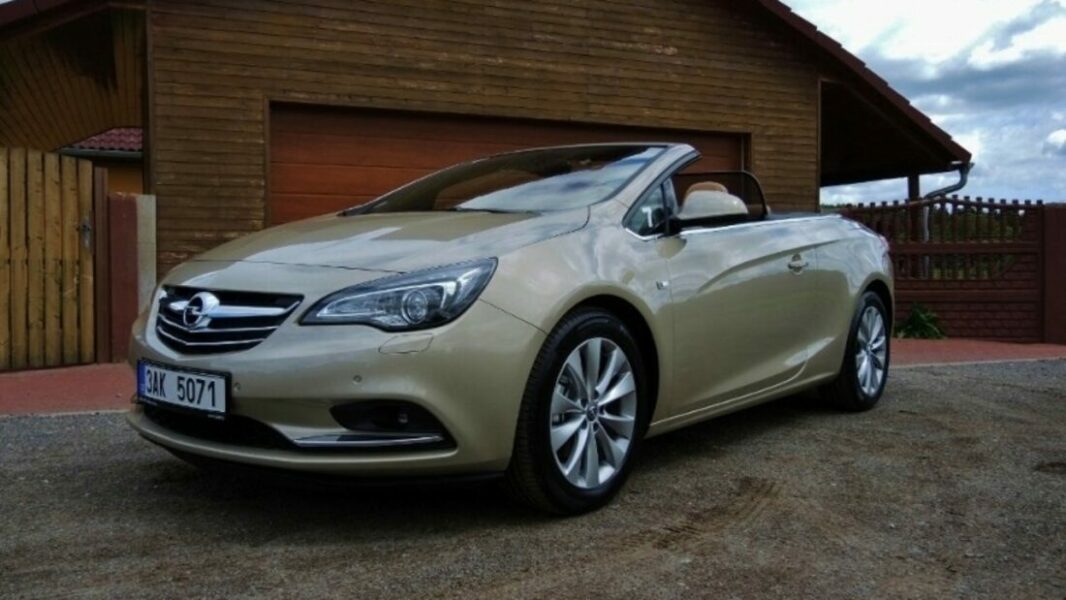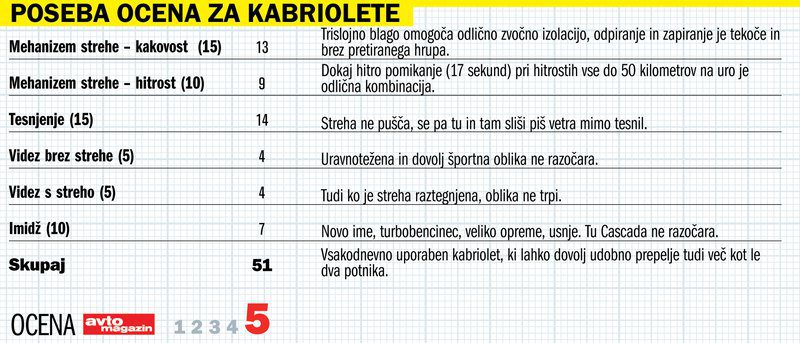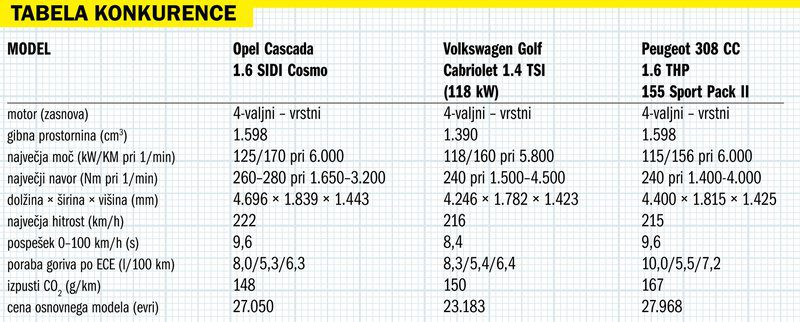
Test: Opel Cascada 1.6 SIDI Cosmo
Content
They chose a completely new name for the new convertible as they wanted to emphasize the fact that the Cascada, as the car is called, is not just an Astra with the roof cut off. It was created on the same platform, but from the very beginning it was designed as a convertible - and above all as a more prestigious and larger model than the Astra.
Compared to its predecessor Astro TwinTop, the Cascada is 23 centimeters longer, which translates it from a car company like the Megane CC, VW Eos or Peugeot 308 to larger convertibles as it is longer than the Audi A5 Convertible and the new convertible Mercedes E-Class.
Excellent, you say, and therefore it is much more expensive. But it is not so. You can buy Cascado for just over 23, and a test one for about 36. And for the money she had something to brag about. Apart from the equipment otherwise included in the Cosmo package (and with this package alone, at no extra cost, it will cost 27k), it also had adjustable automatic bi-xenon headlights, variable damping (CDC), a navigation system and leather upholstery. Even the 19-inch wheels that are so attractive in photos (and live) are not included in the list of extras.
But before we get into some of the more technical details of the Cascade, let's stop for a moment with the price and optional equipment. If we removed a few less essential pieces of equipment from the Cascade test co-payments list, it would be almost as good and much cheaper. Of course, you will have to pay extra for bluetooth (Opel, hands-free system should be standard!), Although it cannot play music from a cell phone, and also for a wind network.
But the Park & Go package would have been easy to pass up (especially since the blind spot monitoring system worked a bit on its own throughout the test), as would the CDC and 19-inch rim chassis. The savings are instantly three thousandths, and the car is no worse - even the leather interior (1.590 euros), which gives the car a really prestigious look (not only because of the color, but also because of the shapes and seams), no. you need to give up and the navigator (1.160 euros) is also not.
However, if you opt for 19-inch wheels, only think of CDC. Their hips are lower and stiffer, so the suspension causes more jerking, and here the adjustable damping does its job well. It can be softened by pressing the Tour button, and then the Cascada will be a very comfortable car, even on bad roads. It is a pity that the system does not remember the last setting and always goes into normal mode when the machine is started.
In addition to the stiffness of the damping, the driver also uses this system to adjust the sensitivity of the accelerator pedal, the operation of electronic safety systems and steering. Press the sports button and everything will be more responsive, but also more solid, and the indicators will turn red.
Location on the road? As you'd expect: mild understeer with no jittery response to more awkward driving commands, and ultimately safety with a well-honed ESP.
As we already wrote, the Cascada is basically built on the same platform as the Astra, only it is larger and sturdier, so the rear can be longer and the body is quite sturdy. On bad roads, it turns out that the miracle of the body rigidity of the four-seater convertible was not achieved on Opel, but the Cascada is still calm, and the vibrations of the convertible are barely perceptible only on a truly vegan road. The electrically adjustable tarpaulin hides between the rear seats and the boot lid and can travel at speeds of up to 50 kilometers per hour and takes 17 seconds to climb or descend. On the Cascada test, the roof was additionally soundproofed for a surcharge, since it was quite three-layer.
Considering that you only have to pay 300 euros for this and the insulation is really great, we would definitely recommend this additional fee. In terms of noise, the engine is well insulated as well, but unfortunately in the Cascada test, passengers at highway speeds (and sometimes below them) were bothered by the occasional whistle of air blowing over windows or roof seals. With the roof down, it turned out that Opel's aerodynamics did a good job. If there is a windshield behind the front seats and all windows are raised, you can easily drive (and communicate with the passenger) even at highly prohibited highway speeds, and with the side windows down, drive on regional roads and jump on them from time to time. the highway is not particularly serviced. I write in the wind.
In fact, how much wind blows to the passengers in the front seats was determined perfectly. Not bad at the rear either, after all, in addition to a larger windshield for the front seats, the Cascada also has a smaller one that can be installed in the rear when there are more than two passengers in the car. There is enough space for adults at the back, but only in width (due to the roof mechanism) there is a little less space - therefore Cascada is four-seater.
When the roof is folded down, or when the bulkhead separating it from the rest of the trunk is placed in a position where the roof can be folded down, the Cascada's trunk is very transformative. This means it is smaller, but still enough to fit two smaller bags and a handbag or laptop bag. Enough for the weekend. For something more, you need to fold the barrier (in this case, the roof cannot be folded), but then the trunk of the Cascade will be large enough for a family vacation. By the way: even the back of the bench can be folded down.
Back to the cabin: the seats are excellent, the materials are also used, and the workmanship is at the level you would expect from such a machine. It sits well, even at the back, depending on what kind of car it is, ergonomics are good when you get used to working with a multimedia system, only transparency is a little worse - but this is one of the compromises of a convertible car. at the time of buying. The driver's view to the left and front is severely limited by the thick (for rollover safety) A-pillar, and the rear window is so narrow (in height) and far away that you can hardly see what's going on behind. Of course, if the roof is folded, there is no problem with rear transparency.
The test Cascado was powered by a new 1,6-liter turbocharged petrol engine labeled SIDI (which stands for Spark Ignition Direct Injection). In the first version, in which it was created and on which the test Cascado was also installed, it is capable of developing a capacity of 125 kilowatts or 170 "horses". In practice, an engine with a classic single coil turbocharger proves to be very smooth and flexible. It pulls without resistance at the lowest revs (maximum torque of 280 Nm is already available at 1.650 rpm), loves to spin fairly easily, and cuts easily with the 1,7 tons empty weight of the Cascade (yes, the body reinforcement needed for a convertible is the most large. know by mass).
It's clear that the 100-horse-per-tonne Cascada isn't a racing car, but it's still powerful enough that the driver almost never needs more power. Consumption? This is not quite a record low. On the test, a little more than 10 liters stopped (but it should be noted that most of the time we even drove along the highway with the roof folded), the circle rate was 8,1 liters. If you want less fuel consumption, you'll have to choose diesel - and then smell it. And even less driving pleasure. And make no mistake: it's not the engine itself that's to blame, but the weight of the Cascada.
And so you can slowly exclude the essence from everything written: there are indeed a few cheaper cars in the lower middle class, but the Cascada differs significantly from them both in size and in the feel it gives. Let's say it is something in between the "ordinary" convertibles of this class and the class of larger and more prestigious ones. And since the price is closer to the former than to the latter, it ultimately deserves a strong positive rating.
How much do test car accessories cost?
Metallic: 460
Park & Go package: 1.230
Adaptive front lighting: 1.230
Security door lock: 100
Carpets: 40
Wind protection: 300
FlexRide Chassis: 1.010
Leather steering wheel: 100
19-inch rims with tires: 790
Leather upholstery: 1.590
Transparency & Illumination Package: 1.220
Radio Navi 900 Europe: 1.160
Park Pilot parking system: 140
Tire pressure monitoring system: 140
Bluetooth system: 360
Alarm: 290


Text: Dusan Lukic
Opel Cascade 1.6 SIDI Cosmo
Basic data
| Sales: | Opel Southeast Europe Ltd. |
|---|---|
| Base model price: | 27.050 € |
| Test model cost: | 36.500 € |
| Power: | 125kW (170 KM) |
| Acceleration (0-100 km / h): | 10,9 with |
| Maximum speed: | 222 km / h |
| Mixed flow ECE: | 10,2l / 100km |
| Guarantee: | 2 years general and mobile warranty, 3 years varnish warranty, 12 years rust warranty. |
| Systematic review | 30.000 km |
Cost (up to 100.000 km or five years)
| Regular services, works, materials: | 526 € |
|---|---|
| Fuel: | 15.259 € |
| Tires (1) | 1.904 € |
| Loss of value (within 5 years): | 17.658 € |
| Compulsory insurance: | 3.375 € |
| CASCO INSURANCE (+ B, K), AO, AO + | 8.465 ( |
| Calculate the cost of auto insurance | |
| Buy up | € 47.187 0,47 (km cost: XNUMX €) |
Technical information
| engine: | 4-cylinder - 4-stroke - in-line - turbocharged petrol - front transversely mounted - bore and stroke 79 × 81,5 mm - displacement 1.598 cm³ - compression ratio 10,5:1 - maximum power 125 kW (170 hp) s.) at 6.000 rpm - average piston speed at maximum power 16,3 m / s - specific power 78,2 kW / l (106,4 hp / l) - maximum torque 260-280 Nm at 1.650-3.200 rpm - 2 camshafts in the head (timing belt) - 4 valves per cylinder - common rail fuel injection - exhaust gas turbocharger - charge air cooler. |
|---|---|
| Energy transfer: | front wheel motor drives - 6-speed manual transmission - gear ratio I. 3,82; II. 2,16 hours; III. 1,48 hour; IV. 1,07; V. 0,88; VI. 0,74 - Differential 3,94 - Wheels 8,0 J × 19 - Tires 235/45 R 19, rolling circumference 2,09 m. |
| Capacity: | 222 km/h top speed - 0-100 km/h acceleration in 9,6 s - fuel consumption (ECE) 8,0/5,3/6,3 l/100 km, CO2 emissions 148 g/km. |
| Transportation and suspension: | convertible - 2 doors, 4 seats - self-supporting body - front single suspension, spring legs, three-spoke wishbones, stabilizer - rear axle shaft, coil springs, telescopic shock absorbers, stabilizer - front disc brakes (forced cooling), rear disc, ABS, mechanical parking rear wheel brake (switching between seats) - rack and pinion steering wheel, electric power steering, 2,5 turns between extreme points. |
| Mass: | empty vehicle 1.733 kg - Permissible total weight 2.140 kg - Permissible trailer weight with brake: 1.300 kg, without brake: 750 kg - Permissible roof load: not included. |
| External dimensions: | length 4.696 mm – width 1.839 mm, with mirrors 2.020 1.443 mm – height 2.695 mm – wheelbase 1.587 mm – track front 1.587 mm – rear 11,8 mm – ground clearance XNUMX m. |
| Inner dimensions: | longitudinal front 890-1.130 mm, rear 470-790 mm - front width 1.480 mm, rear 1.260 mm - head height front 920-990 900 mm, rear 510 mm - front seat length 550-460 mm, rear seat 280 mm - trunk 750 –365 l – steering wheel diameter 56 mm – fuel tank XNUMX l. |
| Box: | 5 Samsonite suitcases (total 278,5 L): 4 pieces: 1 air suitcase (36 L), 1 suitcase (68,5 L), 1 backpack (20 L). |
| Standard equipment: | driver and front passenger airbags – side airbags – ISOFIX mountings – ABS – ESP – power steering – dual-zone automatic air conditioning – power windows front and rear – electrically adjustable and heated rear-view mirrors – radio with CD and MP3 player – multifunction steering wheel - central locking with remote control - steering wheel with height and depth adjustment - height-adjustable driver's seat - split rear seat - rear parking sensors - trip computer - active cruise control. |
Our measurements
| T = 18 ° C / p = 1012 mbar / rel. vl. = 77% / Tires: Bridgestone Potenza S001 235/45 / R 19 W / Odometer status: 10.296 km | |
| Acceleration 0-100km: | 10,9s |
|---|---|
| 402m from the city: | 17,8 years ( 131 km / h) |
| Flexibility 50-90km / h: | 8,9 / 13,2s (IV/V) |
| Flexibility 80-120km / h: | 12,4 / 13,9s (Sun./Fri.) |
| Maximum speed: | 222km / h (WE.) |
| test consumption: | 10,2 l / 100km |
| Braking distance at 130 km / h: | 66,3m |
| Braking distance at 100 km / h: | 37,8m |
| AM table: | 40m |
| Noise at 50 km / h in 3rd gear | 61dB |
| Noise at 50 km / h in 4rd gear | 59dB |
| Noise at 50 km / h in 5rd gear | 57dB |
| Noise at 50 km / h in 6rd gear | 56dB |
| Noise at 90 km / h in 3rd gear | 63dB |
| Noise at 90 km / h in 4rd gear | 61dB |
| Noise at 90 km / h in 5rd gear | 60dB |
| Noise at 90 km / h in 6rd gear | 59dB |
| Noise at 130 km / h in 4rd gear | 65dB |
| Noise at 130 km / h in 5rd gear | 63dB |
| Noise at 130 km / h in 6rd gear | 62dB |
| Idling noise: | 38dB |
Overall rating (341/420)
The Cascada is really going where Opel wants to go: officially overtaking rivals in the same class and against the more prestigious four-seater convertibles.
Exterior (13/15)
The long boot lid conceals the perfectly insulated soft folding roof.
Interior (108/140)
Cascada is a four-seater, but comfortable four-seater car for passengers.
Engine, transmission (56
/ 40)The new turbocharged gasoline engine is powerful, streamlined and reasonably economical in terms of vehicle weight.
Driving performance (58
/ 95)The adjustable chassis provides very good damping when driving on the road.
Performance (30/35)
Adequate torque, ample power, ample operating rev range - the Cascade's performance does not disappoint.
Security (41/45)
There are no NCAP test results yet, but the list of protective equipment is very long.
Economy (35/50)
Consumption was (despite the mostly open roof even on the highway) moderate in terms of the weight of the car.
We praise and reproach
aerodynamics
engine
seat
appearance
Equipment
folding and opening the roof
operation of the blind spot monitoring system
you write around the window seals
